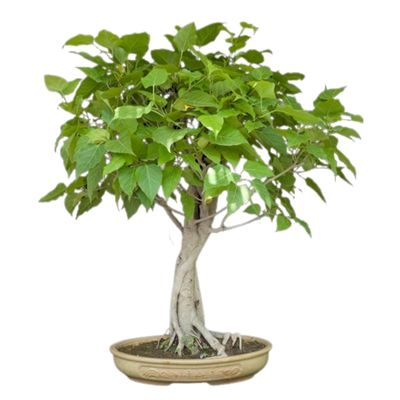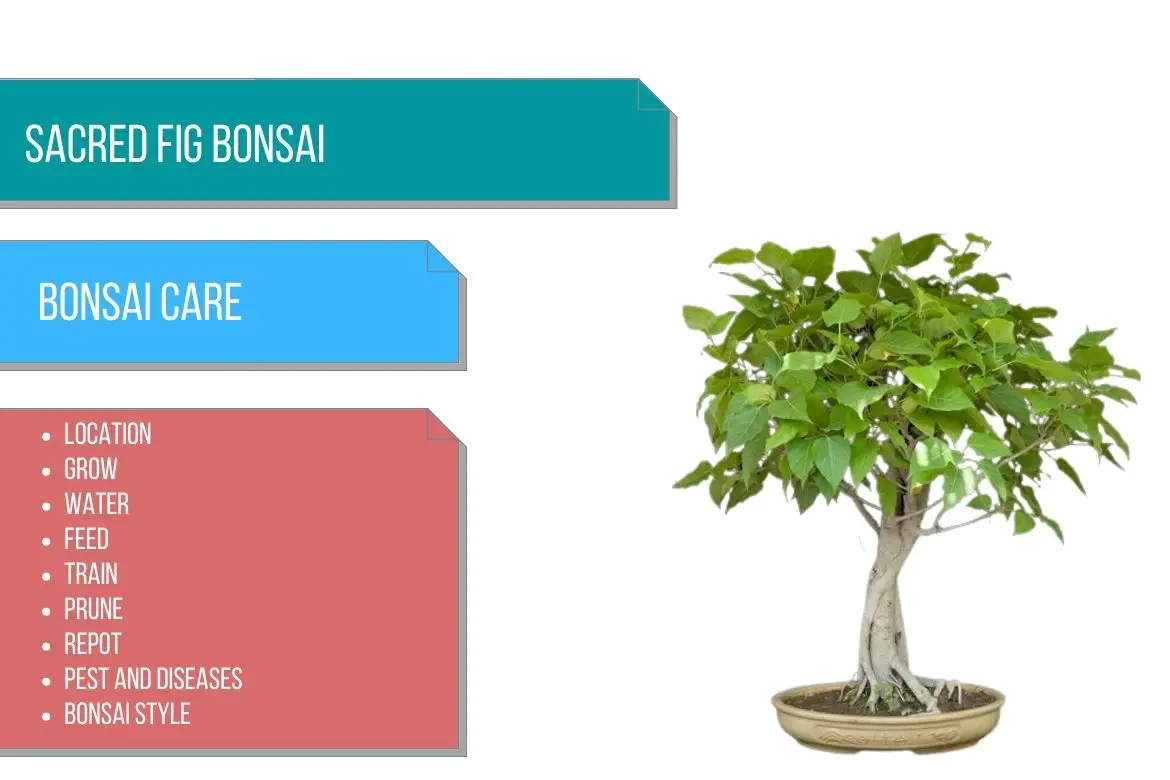
Sacred fig
(Ficus religiosa)
Country of Origin : South Asia
Bonsai Styles : Broom, group
Zone : 10 – 12
Ficus religiosa (also known as Bo tree, sacred fig tree, bodhi tree or peepal tree) is an evergreen tree. (It is named so as it is considered a sacred tree in Hindu and Buddhist religion)
The tree produces strong grayish colored branches which bear alternate leaves.
The leaves also have a very unique shape (compared to other varieties of fig trees used to make bonsai) resembling a heart. The leaves also end in a long tip.
The leaves are also light green in color (with a faint blue tint on mature leaves), have prominent veins and have smooth edges. However, the leaves produced on new shoots appear reddish in color.
The trunk is covered by an an attractive whitish grey bark.
It is common for older ficus religiosa bonsai trees to develop very decorative roots above ground, which are often reminiscent of intricate braids merging with the trunk of the tree.
The Bodhi tree also produces a distinct quiver-like flower which leads to a fruit that turns purple when ripe. The fruit is inedible.
It is a large leafed fig variety such as common fig bonsai (Ficus carica). In case you wish to make a ficus bonsai with smaller leaves, you can check out: Weeping fig bonsai (Ficus benjamina) or Laurel Fig bonsai (Ficus microcarpa) or Boxwood fig bonsai (Ficus buxifolia) or Natal fig bonsai (Ficus natalensis).
These trees also make a good indoor bonsai tree. However, they need plenty of light.
Read more about other bonsai trees species in : Bonsai tree care

Because of its large leaves, the optimum height of the Ficus religiosa bonsai you should aim for is around 20 inches (50 cm). At this size, the leaves will look proportional to the size of the tree.
Hence, it is also not suitable to make small sized bonsai trees.
Best location to keep Sacred fig Bonsai
The Ficus religiosa bonsai tree should be kept in a bright and warm location. Preferably the brightest location in the house.
When kept indoors, the bonsai container should be kept preferably in a south facing window or under a skylight.
In order to keep the tree fresh and healthy, you should bring it outdoors by the end of spring. Keep it in full sunlight and protected from winds.
But, make sure the tree is gradually exposed to light level variations.
If the temperature falls below 60°F (16°C) in the fall, it is time to bring the bonsai bodhi tree back indoors.
In the winter, bonsai can be kept at a temperature between 60°F and 75°F (16°C and 24°C). You can keep the bonsai near a heat source.
Also, in the winter season, a warm room with at least a humidity of 40% is a suitable location.
IMP: Refer sunlight requirements for indoor plants for more indoor gardening ideas. Also, refer to do bonsai trees need sunlight for more indoor and outdoor bonsai location ideas.
Propagation of Sacred fig
Sacred fig tree can be propagated using stem cuttings.
Take stem cuttings (approx 10 cm long) in early spring. Apply some rooting hormone. Plant the cutting and water the pot. You can also cover the pot with a plastic bag.
Maintain a temperature of 71°F and 79°F (22°C and 26°C). The cuttings will take 4-6 weeks to root.
You can also use green softwood cuttings and put them in a jar of water. Change the water every 3-4 days. Cover the jar with a transparent plastic bag. In about 3-5 days, you will see tiny roots emerging from the cutting.
Watering Sacred fig Bonsai
Similar to other ficus bonsai trees, water the Ficus religiosa bonsai tree whenever the soil feels dry to the touch.
This is the safest approach as this tree is more sensitive to over watering than to dryness.
You can use tap water to water this bonsai.
Read watering bonsai tree for more details.
Wiring Sacred fig Bonsai
The tree can be wired at any time of the year. However, wire training should be done only when the branch has lignified.
Wire can be used to shape branches that are one and two years old.
Make sure to check the wires regularly. Specially in the warmer months. This is because, in these periods, the wires are more likely to bite into the branches within a few weeks.
You can remove the wires at the right time to avoid scarring. Rewire the branch if needed.
It is advisable to guy down older branches to prevent damage to the bark of the tree.
Pruning Sacred fig Bonsai
When to prune Sacred fig bonsai?
How to prune Sacred fig bonsai?
The branches of the tree can be pruned throughout the year. However, it is worth mentioning that ficus religiosa does not produce new branches as rapidly as other bonsai Ficus varieties.
When the plant is young, let the new shoots grow 6 to 8 leaves, and then prune the shoot back to 2 to 3 leaves.
On mature specimens, you can prune the shoots depending on your desired length and need.
If the bonsai is kept in an ideal location, this tree will grow vigorously. This makes it easy to completely defoliate the tree. You can even defoliate the tree 2 times in the same growing season.
Defoliation will help you in reducing the size of the new leaves. Also, it will improve the branch structure of the tree.
Repotting Sacred fig Bonsai
When to repot Sacred fig bonsai?
Ficus religiosa bonsai tree can be repotted every 2 years in spring.
At the time of repotting, you should also perform root pruning.
The roots of this tree play a major part in how the tree will look. Hence, keep your desired bonsai shape in mind while you root prune.
Also, try and have an even spread of the roots all around the trunk. Handling the roots wisely will help you in achieving that stunning above ground root system everyone aims for.
You can use a basic free-draining bonsai soil mix as a potting soil.
OR
You can use a mix of sand, loam and peat moss in the ratio 1:1:2.
OR
You can also use a mix of garden compost, sand and fired clay particles in the ratio 1:1:1.
Must Read: Bonsai Soil Recipes
Must read : Choosing the right bonsai container
Feeding Sacred fig Bonsai
From spring until summer, you should use liquid bonsai fertilizer every two weeks.
You should apply feed to the tree every six weeks if the tree is situated in a warm climate during the winter months.
On the other hand, if the tree is placed in a cooler place and the tree has lost all its leaves, start applying feed only when new growth begins in spring.
Read more about bonsai fertilizer and its application.
Diseases and pest of Sacred fig Bonsai
Generally the tree will be trouble free. But, spider mites can cause some issues in rare occasions.
It is possible to reduce the infestation by applying horticultural oils or Neem oil. The use of sulfur sprays against mites has been proven to be highly effective.
A highly diluted solution of soapy water can also be used to wash the leaves.
Sacred fig bonsai care
The new leaves of new shoots will only be red if the tree is exposed to ample sunlight.
The tree will shed its leaves if there is not enough light. You can try and expose the bonsai to more light in case you see signs of leaf drop.
Additionally, the leaves will also drop if the indoor environment for the bonsai tree is too cold or if the tree is over watered.


